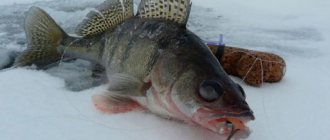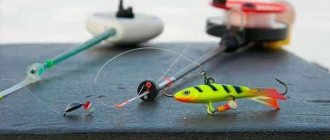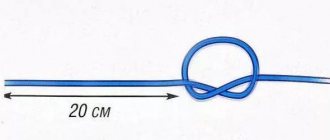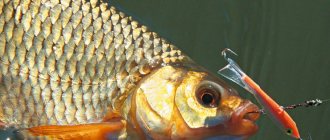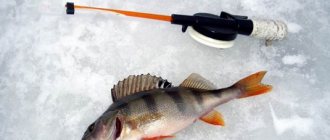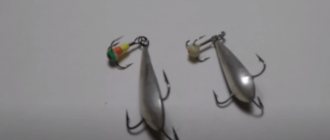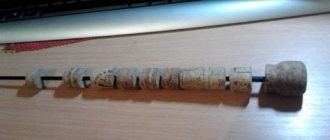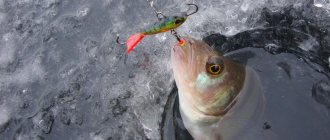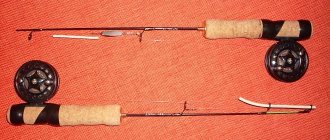How to distinguish original from fake
When purchasing a balancer, an angler should first of all be wary of its cost. A real Rapala balancer cannot cost 200 rubles. When purchasing a balancer, an angler should pay attention to the following features:
- You can distinguish it by the fact that on the back side of the package with the original balancer there is a cross-shaped cut; the fakes do not have it.
- The ring on the back of the bait and on its ventral side on the originals are not covered with paint; on the fakes, the rings are painted the same color as the entire balance beam.
Expert opinion
Knipovich Nikolai Mikhailovich
Zoologist, hydrobiologist. I am interested in fishing at a professional level.
Attention! The principle of operation of the balancer is that after it is reset, it makes a “figure eight” in the water. Stability of the game is a sign of quality. Counterfeits may not meet these requirements.
Technique for catching perch using a balance beam
The main strategy of this fishing is to actively search for a predator, with maximum coverage of the perimeter of the reservoir. The amount of catch here directly depends on the number of holes drilled.
It is advisable to drill holes sequentially at a distance of up to 6 meters from the previous one. The main emphasis should be placed on probable habitats (near snags and branches frozen to the ice, coastal dumps and channels adjacent to the reservoir).
Rocking the hole
The drilled hole needs to be “swinged” with the most popular gear. Depending on the location, different working options are used. At great depths, far from natural obstacles, you can use heavy fishing rods with a load that gives maximum amplitude. Near the shore and near snags, gear for vertical play is used. The main thing is that the fishing gear used already has experience of successful biting.
The swinging process itself consists of a sequence of actions during which the bait:
- sinks to the bottom;
- rises slightly with a jerk of 15 to 30 cm in height.
- falls back down.
This process is repeated several times.
How to play with a balancer for perch: types of postings
The main game of bait is called wiring. It is the most important element of this fishing technique. The number of bites and, as a result, the size of the catch directly depends on its competent execution.
Often, beginners buy expensive, high-quality gear, find a suitable place, but, having cast their fishing rod, sit for several hours without a single bite. Which is doubly offensive when other fishermen nearby are biting one after another. What is the reason for such a failure?
If you put an underwater camera at this moment, you can see that the perch simply swims past the beautiful shiny tackle without reacting to it in any way. The whole point is that the predator does not see it as his prey, since due to incorrect wiring, the movements of the bait do not seem natural.
Balancer fishing technique
There are many options for effective fishing. Below are just a few of them:
- The balancer sinks to the bottom and smoothly rises up to a distance of 50 cm to 1 m, swaying from side to side. Afterwards, a quick jerk is made to lift it and the load drops to the bottom again.
- A sharp rise from the bottom to a distance of up to 50 cm and release.
- Raise 40 cm, short pause, rise 30 cm, medium pause and reset to the starting position.
- A couple of light blows of the load on the bottom, lifting it 20-30 cm and dropping it to the starting position.
- Jig-muscular wiring, consisting of small twitching and swaying with freezing after lifting.
Variant of fishing for perch
The number of necessary repetitions of each wiring and pauses between them depends on the specific situation.
Advantages and disadvantages
Rapala balancers have earned the recognition of fishermen in many countries around the world. This is due to their following advantages:
- extremely catchy not only when fishing from ice, but also during summer fishing;
- have a stable game;
- can be fished both in currents and in still water;
- they can be used to catch various types of predatory fish;
- the Rapala company produces several working models for different fishing conditions;
- You can find a wide range of sizes and colors on sale.
The disadvantages are the following:
- The plastic tail breaks off periodically. However, balancers from other manufacturers also suffer from a similar disease. With careful storage, this disadvantage can be minimized;
- a common drawback of almost all balancers is that when fishing, the front hook of the bait often clings to the edge of the hole and the prey comes off;
- high price.
Options
Color
Lures are available in a variety of colors, which can be roughly grouped into the following categories:
- Balancers in natural colors.
Such baits have a color that resembles fry, which serve as food for predators. As an example, we can cite the colors S, G, SSD (popularly “mouse”). - Balancers in provocative colors.
Good results when catching perch are shown by balancers in BYR (popularly “toad”) and PRT (“parrot”) colors. Also very popular is the “clown” - CLN. - Perch.
The “perch” coloring may have a different background and stripes of different colors, but in general such balancers resemble juvenile striped robber. The most famous colors are P, GGT, FT, LP. - Striped.
Striped balancers have a brighter “acid” background than perch ones. Examples include HT, MTU, GBT, OUT colors. - Speckled.
Balancers of speckled colors have many small specks against the general background of one color or another. There are many such baits, the most famous colors are TS, MR, BLM. - Iridescent.
With such balancers, one color smoothly transitions into another. Popular colors – BSR, GFR, RH. - Fluorescent.
Not long ago, Rapala’s product range included balancers with a light accumulator (fluorescent, luminous). After a short stay in the light, they glow across the water, attracting fish. Such baits can be used when fishing at night, when fishing on thick ice with significant snow cover or at great depths. An example of such a color is GZBP.
Size
In the model range of Rapala balancers there are varieties of baits ranging from 2 to 12 cm in length and weighing from 4 to 34 g.
Where is it produced?
Initially, the country of origin was Finland. Production was then moved to Ireland. Currently, all balancers for winter fishing, as well as wobblers, are produced in Estonia . All other Rapala pseudo-balancers are produced in China.
Those fishermen who own original Finnish balancers can easily find the difference from the Estonian ones. Finnish lures have small notches that resemble scales; Estonian lures have a smooth body. Chinese fakes use low-quality hooks, the paintwork is worse, and the alloy from which the balancers are made differs in specific gravity from the originals.
Catching models
Rapala Jigging Rap
The first model of Rapala balancers to appear on the market and is still the most popular . The body shape of the bait resembles a fish. Available in the following sizes:
- 2 cm – 4 g;
- 3 cm – 5 g;
- 5 cm – 9 g;
- 7 cm – 18 g;
- 9 cm – 25 g.
On sale you can find the old 12-centimeter model, but these balancers have not received recognition, since when suspended, the rear end of the bait outweighs.
Rapala Snap Rap
A recently introduced balancer with a very active game . This is achieved through an asymmetrical tail, which is glued not to the back of the bait, but to its back. There are three standard sizes:
- 4 cm – 4 g;
- 6 cm – 9 g;
- 8 cm – 24.
Rapala Jigging Rap WH
It differs from the classic model by the presence of a three-color drop on the tee, which is the “attack point”.
Balancers with a red tail . On sale you can find baits with lengths of 3, 5, and 7 cm.
Rapala Flat Jig
These balancers are characterized by the following features:
- body flattened laterally;
- the bait has a high specific gravity;
- The balancer glows in ultraviolet rays.
Balancers are designed for fishing in strong currents . This model has only two sizes: 4 cm -16 g, 6 cm -34 g and only ten color options, including black.
Rapala Jigging Shad Rap
The body of this balancer is taller and resembles a crucian carp . A model is available with a length of 5 cm and a weight of 9 g.
Design and execution of the balancer
The tail hook of the original balancers is firmly glued to the tail unit (filled with glue along the entire length of the hook). The hook of the fake is only slightly attached with glue at the base. Accordingly, the lifespan of such a product will be equal to one pike bite. In our case, the fake balancer parted with the tail even before the bites, even at the photography stage.
The original balancer has a flat belly, and this is one of the most important parameters for correct play on the fall (planing) of the bait. The shape of the fake is not far from the shape of the load for the diverter leash. The correct play of this pseudo-balancer is out of the question.
Comparative photo (left – fake, right – original):
How to choose in a store
Before going shopping at a fishing store, a fisherman must decide where, who and how he will catch. This suggests that he should consider:
- the type of fish to be hunted;
- degree of predator activity;
- time – first ice or deep winter;
- fishing conditions: depth in the reservoir, absence or presence of current.
Based on these premises, you can decide on the model of the balancer and its size. The choice of color should be taken responsibly.
Expert opinion
Knipovich Nikolai Mikhailovich
Zoologist, hydrobiologist. I am interested in fishing at a professional level.
Important! When catching an active predator or at shallow depths, you should use brightly colored baits. If there is darkness under the ice, they are caught using luminous balance beams. Passive fish are easier to seduce with lures of natural colors.
Then they decide which brand of balancers to buy. Finnish balancers are traditionally catchy, their properties are not satisfactory. Rapala balancers are favorites in terms of price/quality ratio. You can buy bait on Aliexpress, but there are no guarantees that it will bite well.
Balancer "Rapala" for perch
Perch is not afraid of frost and is one of the favorite fish for winter fishing. Catching perch requires not only high-quality bait, but also special equipment. When choosing a balancer, pay attention to its size. A bait in the shape of a small fish from 30 to 50 mm is used for medium-sized perch, and a bait up to 30 mm is used for catching smaller fish. Small perches are grouped in schools and therefore are often caught on a small balancer.
The catch also depends on the color of the Rapala balancers. When the perch is active, use bright yellow, red and orange baits. A green, gray or blue balancer is suitable when there is no bite. The silvery tint of the bait is ideal for muddy water. For successful fishing and catching predators, you should stock up on balancers of different colors. For winter fishing for perch, the most catchy colors according to the Rapala classification of colors and shades are:
- FT – perch color (classic);
- BSR;
- Red Head;
- CLN.
Catching predators
Pike
To catch pike, large balancers are used - 7 and 9 cm Jigging Rap . Pike is caught both in deep and shallow water, and sometimes the thickness of the layer of water between the lower edge of the ice and the bottom is only a couple of tens of centimeters. For pike fishing, balancers with a sweeping action . The tee on the bait should be replaced with a more powerful one.
Perch
Catching perch with balance beams is extremely effective if used correctly. When fishing on first ice, you should use bait of the largest possible size for specific conditions. With the increase in ice cover and the deterioration of the oxygen regime under the ice, it is necessary to switch to smaller balancers. The game of balance when fishing for perch should be diversified, since this predator is the most picky about the animation of the bait.
Zander
To catch pike perch, different models of Rapala balancers are used. The bait colors and sizes are selected based on personal experience and preferences of the predator.
On open water
In open water, you can successfully fish with balance beams in a plumb line, using the same techniques as in winter fishing. Jig Flat model is used not without success by spinners for casting. Jigging Shad Rap used to catch predatory fish by trolling.
Rapala Jigging Rap for open water fishing
Over the years, fishermen began to use the Jigging Rap for open water fishing. The Rapala balancer is similar in appearance to the classic minnow bait, but has a lot of weight, which allows it to reach depths and lure predators. The bait is equipped with single hooks on both sides, and in the middle there is a tee. The balancer fin is made of plastic. Thanks to this design, the bait easily performs complex patterns and attracts the attention of fish when fishing with regular casting.
Fisherman Linder Ohl perfected the casting technique for this type of fishing. Its technology is that the bait is cast and immediately sinks to the bottom. The spinning rod rises sharply and then falls, thanks to which the balancer plays perfectly. With such wiring, smooth movements and accuracy are necessary so that the hooks do not get caught on snags or stones at the bottom of the river. Using different models of Jigging Rap lures, you can catch fish such as grass carp, rudd, sea bream, and cichlids.
When fishing by twitching, the Rapala balancer, imitating the movements of a small fish and swaying in different directions, moves deftly. With such wiring, the fishing box will contain fast, predatory fish - largemouth bass or horse mackerel.
The peculiarity of Jigging Rap lures is their special game and unusual movements. And the ideally selected proportion of the weight of the bait and its dimensions makes it possible to catch even very cautious fish that do not come close to the coastline.

